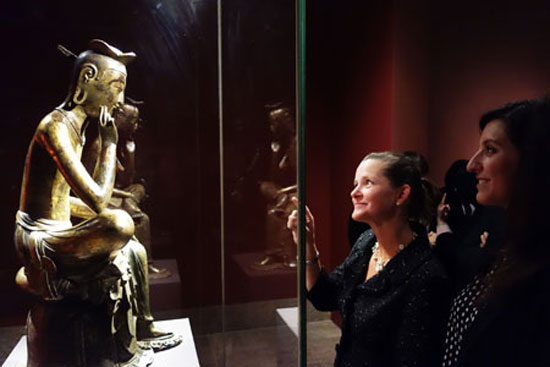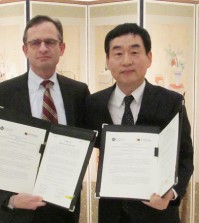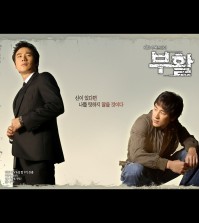- California Assembly OKs highest minimum wage in nation
- S. Korea unveils first graphic cigarette warnings
- US joins with South Korea, Japan in bid to deter North Korea
- LPGA golfer Chun In-gee finally back in action
- S. Korea won’t be top seed in final World Cup qualification round
- US men’s soccer misses 2nd straight Olympics
- US back on track in qualifying with 4-0 win over Guatemala
- High-intensity workout injuries spawn cottage industry
- CDC expands range of Zika mosquitoes into parts of Northeast
- Who knew? ‘The Walking Dead’ is helping families connect
Korean art on exhibit at world-renowned U.S. museums

The Maitreya in Meditation, a 7th-century gilt-bronze Buddhist statue designated as National Treasure No. 83, is on display at the “Silla: Korea’s Golden Kingdom” exhibition at the Metropolitan Museum of Art (Met) in New York, the United States. The exhibition will continue through Feb. 23, 2014, featuring a total of 132 objects from the Silla Kingdom.
(Courtesy of National Museum of Korea)
Silla, Joseon artworks on show in world-renowned museums
By Chung Ah-young
Korean art has been regarded as a spinoff from those of China and Japan, which are believed to possess the core of Asian cultural and aesthetic values. It is rare to have the opportunity to appreciate the sheer essence of Korean art on the international scene.
However, as Korea’s national profile is on the rise partially thanks to the cultural influence of “hallyu,” or Korean wave, global interest in Korean cultural roots is also spiking. Ongoing exhibitions in the United States featuring ancient artwork from Korea offer an opportunity for non-Korean visitors to discover the unknown beauty of Korean ancient art which is discernible among Asian cultures.
Supported by the National Museum of Korea, two major exhibitions on Korean art are taking place in east and west coast cities of the United States. “In Grand Style: Celebrations in Korean Art During the Joseon Dynasty” and “Silla: Korea’s Golden Kingdom” allow for a large-scale and in-depth exploration of rare objects from two ancient Korean kingdoms ― Silla (B.C. 57-A.D. 935) and Joseon (1392-1910). It is notable to compare the two distinctive cultures based on different ruling ideologies ― Buddhism in Silla and Confucianism in Joseon.

A folding screen titled “Fifty-ninth Birthday Banquets for Elder Queen Mother Sunwon, 1848” is exhibited at the San Francisco Asian Art Museum. The “In Grand Style: Celebrations in Korean Art during the Joseon Dynasty” exhibition will continue through Jan. 12, 2014.
(Courtesy of National Museum of Korea)
Silla ― Buddhist culture
The “Silla: Korea’s Golden Kingdom” exhibition is being held at the Metropolitan Museum of Art (Met) in New York. The exhibition, which will continue through Feb. 23 next year, features a total of 132 objects including the Maitreya in Meditation, a 7th-century gilt-bronze Buddhist statue designated as National Treasure No. 83, and other golden artifacts.
This is the first of its kind to introduce such a large number of Silla artifacts in Western countries.
“It is a rare opportunity to experience the visual splendor of the Silla Kingdom in the first exhibition in the West devoted to the subject. These stunning works of art are rich in beauty and history, extending back to the first millennium and to a kingdom largely unknown to our audience. Their story will be a revelation to the public,” said Thomas P. Campbell, director and CEO of the Met.
Campbell said that Silla developed its own unique culture after importing foreign cultures including that of the Arab civilization. The Silla culture culminated after adopting Buddhism as the national ideology in 527.
The exhibition consists of three parts. The first features “Treasures from Silla Tombs” which displays various golden objects from gold regalia, including a crown-and-belt set; gold and glass-beaded jewelry; vessels of clay and precious metals; weapons; and horse trappings and fittings for riding. The relics were excavated from Hwangnam Daechong (The Great Tomb of Hwangnam), the largest Silla tomb in Gyeongju, North Gyeongsang Province, the old capital of the Silla Kingdom.
The second is “Imported Luxuries and Exotic Imagery,” which shows foreign-made luxury goods excavated from Silla royal tombs including more than 30 Roman-style glass vessels. This section displays objects such as sheaths and daggers and Roman-style glasswork, and stone and earthen sculptures on which foreign languages are inscribed, which show cultural exchanges with foreign countries. Ceramics imported from China dating to the seventh through the ninth century, including porcelain, celadon, and tricolor earthenware, are on display.
The objects indicate how the kingdom developed foreign relations by accepting other cultures and influencing other countries promoting its own culture, which contributed to Silla’s cultural richness.
The third part is “Buddhism: A New Tradition” which displays how Buddhism transformed Silla society and culture, bringing changes in burial customs and the creation of new artistic tradition. The use of gold reflects this flamboyant Buddhist culture. Silla Buddhist art shares similarities with that found in China but is reminiscent of earlier imagery from India and Central Asia, the Korean museum said.
The museum said that Silla’s representations of Buddhas and bodhisattvas from the sixth and early seventh centuries are characterized by round, unarticulated bodies sometimes covered with thick, cascading drapery. Later Buddhist icons have sensuous physiques with articulated chests and waists and wear thin clothing.
Joseon ― Confucian rituals
The San Francisco Asian Art Museum is presenting “In Grand Style: Celebrations in Korean Art during the Joseon Dynasty,” the first major U.S. exhibition to explore the extravagant ceremonies of Korea’s Joseon Kingdom (1392-1910). The exhibition, which will continue through Jan. 12 next year, presents more than 110 important objects used in royal banquets or celebration events such as birthdays, weddings and political appointments along with dance, music and cuisine.
The royal rituals are based on the kingdom’s national ideology of Confucianism, which put more emphasis on rituals and orders for the reign of peace. Many of these celebrations were recorded in comprehensive detail through writings and paintings in “uigwe”or the royal protocols. These documents are detailed enough to represent the ceremonies today.
The exhibition consists of four themes ― “What it Meant to Be a King During the Joseon Dynasty”; “Royal Processions and Banquets”; “The Power of Women at the Royal Court”; and “the Lives and Celebrations of the Joseon Dynasty’s People.” The exhibition includes an ornate palanquin more than 8 feet long used for carrying the king; a book of praise for King Taejo, made entirely of jade and inscribed with gold; a 64-foot-long handscroll depicting King Jeongjo’s famous parade to his father’s tomb; a royal throne; ceremonial robes; as well as the seals of kings and queens; and protocols depicting paintings of royal banquets.
“With ‘In Grand Style,’ we celebrate the rich pageantry of the Joseon dynasty,” said Jay Xu, director of the Asian Art Museum. “It is fitting that we should do so in our 10th year in the museum’s Civic Center location. In 2003 we opened with a show about KoreaGoryeo dynasty. Ten years later, we celebrate the marvelous arts of Korea, and ultimately the art of celebration itself, through this exhibition focusing on the succeeding Joseon dynasty.”












![일본 사도광산 [서경덕 교수 제공. 재판매 및 DB 금지]](http://www.koreatimesus.com/wp-content/uploads/2024/07/PYH2024072610800050400_P4-copy-120x134.jpg)



hppy romz
November 18, 2017 at 12:03 PM
A Hunter’s Moon has special characteristics; the time between sunset and each night’s successive moonrise is noticeably short). Those characteristics can be seen by Northern Hemisphere full moon-watchers this weekend, although the effect is mitigated this year, due to the late date of this year’s full Hunter’s Moon.